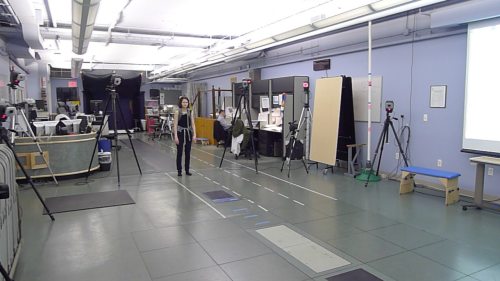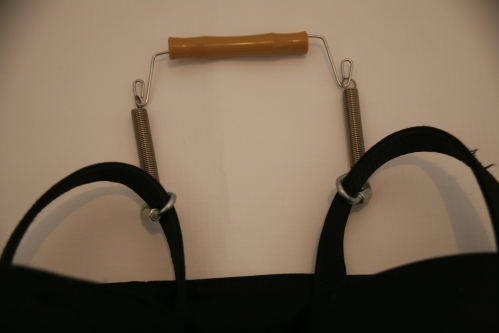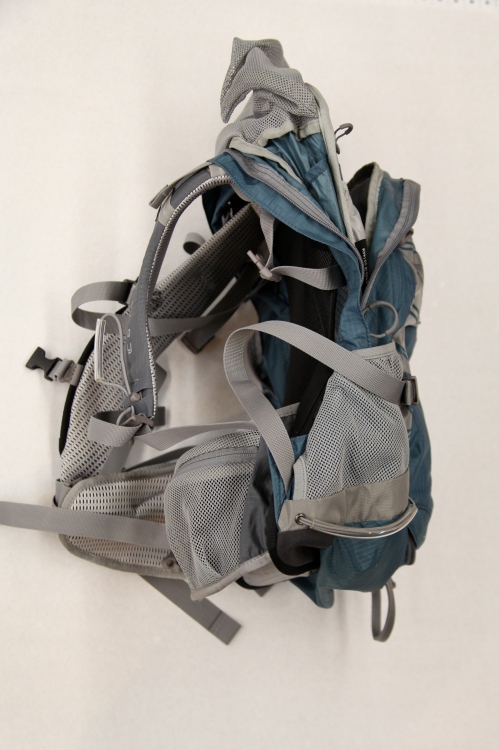t0nnelabbiomechanics
May 4, 2012
Final Presentation
I had two students (Tiffany & Eric) do a demo first by walking with regular bag with 11 pound weight and then I suspended those bags. Eric said the suspended version felt 30-40% lighter.
May 1, 2012
Suspended Backpack Prototype Light Tests
I am using the Osprey frame with the two parallel springs (McMaster Type 302 SS Ultra-Precision Extension Spring 1.25″ L Inside Ends,.360″ OD,.037″ Dia, with spring constant of 4.08) attached to the frame. Then I have a super light dyneema bag holding an 11 pound weight.
Basic Setup without lights
I made later made it more symmetrical and sturdy.
Here is the light setup. White light attached to bag. Red light attached to my hip/ belt. You can’t see well in this photo but I attached a low friction white sheet of self reinforcing polypropylene from Don & Low in Scotland to reduce friction and enable spring bag to bounce up and down better. Also, there are two loose, smooth pieces of black webbing wrapped around the spring bag and the frame so that the spring back doesn’t bounce horizontally against the frame and then away from my body, but instead only bounces vertically.
Me walking
Below is with the red light actually taped to my hip, not my clothes.
It shows that my hip is out of phase with the backpack so they will cancel.
April 28, 2012
Frame Design
Using Osprey Sirrus 24 pack’s trampoline back as inspiration, Measured length of metal frame rods and diameter with caliper.
Frame measures 60 inches (5 feet) + diameter is 3/16 inch
Cross Beams measure 21 inches (1.75 feet) + diameter is 1/8 inch
Frame assembly plan sketches
I decided that for my first prototype I would just hack the Osprey and use its frame, and for future prototypes I will try to make my own frame. David at Metalliferous warned me that my frame will not be as good without a good jig and pressure machines to push the aluminum into place.
Full bag – pre hack
Hack open
resulting frame + straps that I will use for my suspended load prototype
April 26, 2012
Suspension Design
spring constant lbs/in is 8.3
With my first order of springs, I ordered so one spring has this spring constant. Now I realize I will need at least 2 springs in parallel for each side of a handle (if handheld) or at least one for each strap (if backpack).
As you can see, these are very long.
under load springs/ waistbelt idea
“There’s a rule we have in engineering machine design: everything is a spring. Any material, if you push on it enough, will squish. Different configurations of materials will do this differently – whether it’s the material in your video, an inflated ball, foam, metal springs, etc. There are a ton of ways to add springiness to your bag. I think it’s important to do a survey of options, but choose 1 or 2 to really prototype with and ignore the others so you don’t get distracted. You can always go back and redo, but if you push forward with 15 different options you may stall more than you move.”
– Dustyn
April 26, 2012
Final Project Step 2: Suspension Plan
Suspension Bag Overview
Suspension bags move in the opposite direction of the wearer. When you walk normally, your hips move up and down, and your bag moves with you. This movement causes extra force on your joints, especially when you’re carrying heavy laptops and devices. Suspension bags can effectively reduce the force you’re joints feel. Professor Larry Rome at University of Pennslyvania proved this method can reduce the total peak vertical force on the wearer’s body by 60%.
Progress to Date
I aim to apply Rome’s principles to daily urban bag loads and perform more extensive testing. To determine if a spring-mounted suspended-load-carrying system was a viable option for reducing fatigue experienced by my demographic, I performed an initial feasibility study with biomechanics professor Dustyn Roberts. I hypothesized that load-carrying systems using springs and suspension to counteract the vertical force of loads will cause less fatigue. After assembling and testing a prototype of the load attached to extension springs, preliminary results (attached) showed the mass moving out of phase with the carrier’s gait as expected.[i]
Next Steps
My preliminary results proved that suspension works with handheld loads. Next I want to make suspension work for bags worn on the back since young professionals like to carry bags both on their backs and in their hands.
Timeline
Rapid Prototyping & Testing
I will develop the bag following an iterative design process involving continuously creating and testing prototypes, then reevaluating and making adjustments.
1. Make Suspended Load Backpack (in addition to my current handheld prototype)
The first step is to buy materials and develop a succession of suspended-load bag prototypes. Increased friction between the backpack and back will require trial and error testing of springs and bungees.
2. Test
I will measure fatigue by testing ground reaction forces during gait when a person holds the bag on the back versus in the hand. I should be able to visualize differences between fixed and spring-mounted bags in the pressure patterns if fatigue is reduced. I will also test different designs’ distribution of pressure forces on the back.
Refinement & Finalization
As I receive test results, I will update the bag design accordingly. Moving forward, I intend to distribute final prototypes to my target demographic to test if their load carrying improves, and then hopefully move from prototypes into production.
[i] Holtz, Melissa, and Dustyn Roberts. Design of Suspended Load Backpacks for Young Urban Professionals. American Society of Biomechanics Submission, 9 Mar. 2012.
April 26, 2012
Final Project Step 1: Best Possible “Locked” Bag
Best possible “locked” bag based on biomechanic principles
1. Convertible strap bag so can have option of different strap positions
2. adjustable lumbar padding
padding of different thicknesses have velcro sewn to them and then there is a velcro panel in the bag the padding pieces can lock into.
3. Super lightweight, super strong material
I’m working with a new, lightweight, superstrong, waterproof, and durable material called Dyneema, which substantially reduces the bag weight.
However, these functionalities have limited effect.
Only exercise was found effective for preventing self-reported back pain in seven of eight trials (effect size 0.39 to >0.69). Other interventions were not found to reduce either incidence or severity of BP episodes compared with controls. Negative trials included five trials of education, four of lumbar supports, two of shoe inserts, and four of reduced lifting programs.
– Value-based care in the management of spinal disorders: a systematic review of cost-utility analysis. Indrakanti SS, Weber MH, Takemoto SK, Hu SS, Polly D, Berven SH. Washington University in St Louis School of Medicine, St Louis, MO, USA.
March 27, 2012
Week 8 – Spine + Product Design
What we really need to do to design is look at the extremes.
The weakest or the person with arthritis or the athlete, the strongest or the fastest person. Because if we understand what the extremes are, the middle will take care of itself. – Dan Formosa, Objectified film
This week’s assignment:
Choose one joint. Make a physical model of it, either 2D or 3D, in a medium of your choosing. This could be embroidery, jello, 3D printed CAD model, etc. It does not need to be to scale. Bonus points if it moves.
My idea:
A spine is structured like a sandwich with two bones and a disk in the middle, so I am thinking of making an edible model of a spine in the form of a sandwich.
Some silly ideas: full course spine sandwich, savory to sweet sandwich, fondue, smores, corn cobs, shish kabob
here was my first attempt at an edible spine model, made out of gummy candy:
(orange = disk, clear = vertebrae, green= spinal cord)
Find a journal article on that injury at that joint, and include a reading response in your blog post.
Katzman, Wendy, Eric Vittinghoff, Kris Ensrud, Dennis Black, and Deborah Kado. “Increasing Kyphosis Predicts Worsening Mobility in Older Community-Dwelling Women: A Prospective Cohort Study.” Journal of the American Geriatrics Society 59.1 (2011): 96-100. Print.
“Excessive kyphosis, an exaggerated curvature of the thoractic spine, is the leading cause of sagittal plane deformity in older adults.
A small amount of anterior thoracic curvature is normal because of the shape of the underlying vertebrae and discs. Around the fifth decade of life, kyphosis tends to increase with age.
Greater kyphosis angle predicted longer mobility performance times. Increasing kyphosis angle is independently associated with worsening mobility. The study suggests that increasing kyphosis predicts longer Timed Up and Go Test (TUG), a test of functional mobility that has been used clinically to predict falls, thus increasing the risk for falls, functional decline, disability, and frailty.
Increasing kyphosis is a significant factor that should be considered
when developing interventions aimed at preventing functional decline. Increasing kyphosis may be part of an aging syndrome associated with bone loss, fractures, and muscle weakness leading to decline in mobility, but it is important to recognize that greater kyphosis can be easily clinically identified and that effective treatments that reduce kyphosis are available.
Increasing kyphosis should be studied to determine whether interventions that prevent or reduce increasing kyphosis prevent mobility decline.
Data suggest the level of kyphosis can be reduced in persons with excessive kyphosis through exercise and bracing.”
My Response
Because increasing kyphosis is independently associated with worsening mobility, and so many young people who use laptops assume a an excessive kyphosis position while working on laptops, I wonder if as young people age, if young people will develop excessive kyphosis and worsening mobility earlier than age 50.
Typical ITP laptop work postures
(Thanks to Peter, Alex, and Noah for letting me use a photo of them.)
More Info about Kyphosis posture habits in computer desk setups
“To understand the best way to set up a computer workstation, it is helpful to understand the concept of neutral body positioning. This is a comfortable working posture in which your joints are naturally aligned. Working with the body in a neutral position reduces stress and strain on the muscles, tendons, and skeletal system and reduces your risk of developing a musculoskeletal disorder (MSD).”
http://www.osha.gov/SLTC/etools/computerworkstations/positions.html
“Lower display heights increased head and neck flexion with more spinal asymmetry when working with paper.
Posture is an important component of the physical impact of computer use (e.g. Burgess-Limerick et al., 1999; Straker et al., 2000) and is widely used to estimate musculoskeletal stress with evidence that postures away from the vertical result in greater gross moments (e.g. Chaffin, 1973) and that postures nearer the end of available range result in increased tissue stresses (e.g. Dolan et al., 1994).
Our research clearly shows the increased head and neck asymmetry associated with the use of paper information technology, compounding the potential increased risk associated with greater head and neck flexion.
Risk can arise from: increased gravity resisting moment with increased angulation away from vertical, increased pressure/tension on tissues at more extreme postures, and also from repetition and monotony.
In early epidemiological studies [Hunting et al., 1981] and [Starr et al., 1985] found musculoskeletal symptoms tended to increase with lower displays whereas more recently Marcus et al. (2002) found the opposite.
One of the major difficulties in summarising the available evidence on the effect of display height on posture is the range of posture measures used.
– Straker, L., R. Burgesslimerick, C. Pollock, K. Murray, K. Netto, J. Coleman, and R. Skoss. “The Impact of Computer Display Height and Desk Design on 3D Posture during Information Technology Work by Young Adults.” Journal of Electromyography and Kinesiology 18.2 (2008): 336-49. Print.
Product Design Solution
Though display height is not always directly related to musculoskeletal symptoms, because it is related in many cases, the product I would design to help with this problem is a laptop with an adjustable height screen.





































